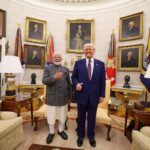In the wake of a severe tariff shock from the U.S., India is pivoting its economic strategy away from a tariff war and toward an aggressive export diversification plan. The move comes as U.S. Treasury Secretary Scott Bessent delivered a blunt assessment of the trade standoff, framing it as a tool to influence India’s geopolitical alignment.
With a new 50 per cent U.S. tariff now in effect, tariffs on Indian textiles and apparel have skyrocketed from 13.9 per cent to nearly 64 per cent. This abrupt increase has a significant impact on India’s exports to the U.S., a trade relationship that brought in over $60 billion last year.
According to the Global Trade Research Initiative (GTRI), the new tariffs affect a staggering two-thirds of India’s goods shipped to the U.S. and could cause a 70 per cent collapse in textile and apparel export volumes.
Despite the economic pressure, India has chosen a different path than a retaliatory tariff war. Instead, it is launching a comprehensive counter-strategy designed to build a more resilient and less dependent export economy.
A Pivot to 40 New Markets
India’s new strategy focuses on mitigating the immediate damage while securing long-term growth. The plan centers on an aggressive push into 40 new markets, including key economies in Europe and Asia.
- Targeted Outreach: Export Promotion Councils will lead dedicated campaigns in countries like the UK, Japan, Germany, and Australia. The goal is to reduce reliance on the U.S. market and tap into these economies, which import over $590 billion in textiles annually.
- Brand India: The strategy shifts the marketing focus from price to value, promoting Indian textiles as high-quality, sustainable, and innovative products under a unified “Brand India” identity.
- Domestic Support: The government is exploring emergency support for affected businesses, including low-cost export credit and financial assistance for small and medium enterprises (SMEs).
Ajay Srivastava, founder of GTRI, believes India’s large domestic market—which accounts for roughly 60 per cent of its GDP—will provide a crucial buffer against the external shock. “The very big domestic market can happily absorb some of the shocks,” he said.
U.S. Official’s Remarks and Broader Implications
While India is focused on its diversification plan, comments from U.S. Treasury Secretary Scott Bessent shed light on the diplomatic friction behind the trade dispute. Speaking with Fox Business, Bessent described India’s trade negotiations as “performative” and highlighted Washington’s structural advantage. “The U.S. is the deficit country… It’s the surplus country that should worry,” he stated, alluding to India’s significant trade surplus.
SBI Research also weighed in on the issue, cautioning that the new tariffs are a “bad policy decision” for the U.S. itself. The report predicts the duties could reduce U.S. GDP growth by as much as 50 basis points and fuel domestic inflation.
Ultimately, the success of India’s strategic pivot will be a critical test of its ability to navigate a new era of geopolitical trade conflicts. It could determine not only the fate of millions of jobs in the textile industry but also whether India can forge an independent path in a complex global landscape.


![textile-export[1]](https://southasianherald.com/wp-content/uploads/2025/08/textile-export1.jpeg)



